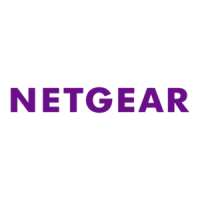S350 Series 24-Port (PoE+) and 48-Port Gigabit Ethernet Smart Managed Pro Switches
Configure Quality of Service User Manual197
• Source MAC. Select this radio button to require a packet’s source MAC address to
match the specified MAC address. After you select this radio button, use the following
fields to configure the source MAC address match criteria:
- Address. The source MAC address to match. The source MAC address is
specified as six two-digit hexadecimal numbers separated by colons.
- Mask. The MAC mask, which specifies the bits in the source MAC address to
compare against the Ethernet frame. Use Fs and zeros to configure the MAC
mask.
An F means that the bit is checked, and a zero in a bit position means that
the data is not significant. For example, if the MAC address is aa:bb:cc:dd:ee:ff,
and the mask is ff:ff:00:00:00:00, all MAC addresses with aa:bb:xx:xx:xx:xx result
in a match (where x is any hexadecimal number). Note that this is not a wildcard
mask, which ACLs use.
• Destination MAC. Select this radio button to require a packet’
s destination MAC
address to match the specified MAC address.
After you select the radio button, use
the following fields to configure the destination MAC address match criteria:
- Address.
The destination MAC address to match.
The destination MAC address
is specified as six two-digit hexadecimal numbers separated by colons.
- Mask. The MAC mask, which specifies the bits in the destination MAC address to
compare against an Ethernet frame. Use Fs and zeros to configure the MAC
mask.
An F means that the bit is checked, and a zero in a bit position means that
the data is not significant. For example, if the MAC address is aa:bb:cc:dd:ee:ff,
and the mask is ff:ff:00:00:00:00, all MAC addresses with aa:bb:xx:xx:xx:xx result
in a match (where x is any hexadecimal number). Note that this is not a wildcard
mask, which ACLs use.
• Protocol Type. Select this radio button to require a packet’
s Layer 4 protocol to match
the specified protocol, which you must select from the menu.
You can also select
Other from the menu and enter a protocol number from 0 to 255.
• Source IP. Select this radio button to require a packet’s source IP address to match
the specified IP address.
After you select the radio button, use the following fields to
configure the source IP address match criteria:
- Address. The source IP address format to match in dotted-decimal.
-
Mask. The bit mask in IP dotted-decimal format indicating which parts of the
source IP address to use for matching against packet content.
•
Source L4 Port. Select this radio button to require a packet’s
TCP/UDP source port to
match the specified protocol, which you must select from the menu. You can also
select Other from the menu and enter a port number from 0 to 65535.
• Destination IP. Select this radio button to require a packet’s destination IP address to
match the specified IP address.
After you select the radio button, use the following
fields to configure the destination IP address match criteria:
- Address. The destination IP address format to match in dotted-decimal.
-
Mask. The bit mask in IP dotted-decimal format indicating which parts of the
destination IP address to use for matching against packet content.

